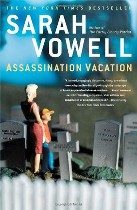 Sarah Vowell •
Sarah Vowell •
Assassination Vacation •
Sarah Vowell does in print what Ken Burns does on film. She fixates on one aspect of American history and prowls its back alleys relentlessly, ferreting out the obscure, poignant, bizarre details that make for an utterly compelling narrative.
Her topic here is the fatal shootings of Presidents Lincoln, Garfield, and McKinley. Vowell traipses around the country visiting assassination-related sites: memorials, prisons, homes, libraries, and museums displaying artifacts from blood-stained clothing and preserved body parts to a lone ice skate (McKinley’s). But her style is less journalism than journey, commingling history with humor and personal anecdote.
Vowell’s taste for the macabre is shared by her three-year-old nephew, who accompanies her on some of these jaunts. “Owen is the most Hitchcockian preschooler I’ve ever met,” she says with auntly pride. “He knows maybe ninety words and one of them is ‘crypt’. ” At the cemetery where Lincoln conspirator Lewis Powell is interred, Owen complains, “It’s not so scary here.”
Along the way, we learn that CBS newsman Roger Mudd is a distant relative of the Samuel Mudd who set John Wilkes Booth’s broken leg. That the 1931 ceremony dedicating the Lincoln Memorial was a segregated event. That the recurring theme in Garfield’s diaries is “I’d rather be reading.” That neighbors constructed a special rail spur so the dying Garfield could travel comfortably to his oceanfront cottage. And that Vowell, attending social functions, sits muttering to herself, “Don’t mention McKinley. Don’t mention McKinley.”
Then there’s Lincoln’s oldest son, who witnessed two assassinations and arrived on the scene moments after a third. Vowell affectionately calls him “Jinxy McDeath.”
It isn’t until the book’s closing paragraphs that we learn why she undertook this morbid odyssey. Like so much about Vowell, it’s not what you might expect.







Your email address will not be published.